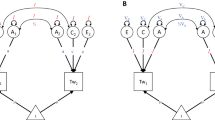Behavioral geneticists commonly parameterize a genetic or environmental covariance matrix as the product of a lower diagonal matrix postmultiplied by its transpose—a technique commonly referred to as “fitting a Cholesky.” Here, simulations demonstrate that this procedure is sometimes valid, but at other times: (1) may not produce fit statistics that are distributed as a χ2; or (2) if the distribution of the fit statistic is χ2, then the degrees of freedom (df) are not always the difference between the number of parameters in the general model less the number of parameters in a constrained model. It is hypothesized that the problem is related to the fact that the Cholesky parameterization requires that the covariance matrix formed by the product be either positive definite or singular. Even though a population covariance matrix may be positive definite, the combination of sampling error and the derived—as opposed to directly observed—nature of genetic and environmental matrices allow matrices that are negative (semi) definite. When this occurs, fitting a Cholesky constrains the numerical area of search and compromises the maximum likelihood theory currently used in behavioral genetics. Until the reasons for this phenomenon are understood and satisfactory solutions are developed, those who fit Cholesky matrices face the burden of demonstrating the validity of their fit statistics and the df for model comparisons. An interim remedy is proposed—fit an unconstrained model and a Cholesky model, and if the two differ, then report the difference in fit statistics and parameter estimates. Cholesky problems are a matter of degree, not of kind. Thus, some Cholesky solutions will differ trivially from the unconstrained solutions, and the importance of the problems must be assessed by how often the two lead to different substantive interpretation of the results. If followed, the proposed interim remedy will develop a body of empirical data to assess the extent to which Cholesky problems are important substantive issues versus statistical curiosities.
Similar content being viewed by others
References
G. Carey H. H. Goldsmith A. Tellegen I. I. Gottesman (1978) ArticleTitleGenetics and personality inventories: the limits of replication with twin data Behav. Genet. 8 299–313 Occurrence Handle10.1007/BF01067394
L. J. Eaves H. J. Eysenck N. G. Martin (1989) Genes, Culture and Personality: An Empirical Approach Academic Press New York
D. W. Fulker (1978) ArticleTitleMultivariate extensions of a biometrical model of twin data Progr. Clin. Biol. Res. 24A 217–236
H. B. Gough (1964) CPI Manual Consulting Psychologists Press Palo Alto, CA
J. C. Loehlin (1992) Genes and Environment in Personality Development Sage Thousand Oaks, CA
J. C. Loehlin R. C. Nichols (1976) Heredity, Environment, and Personality University of Texas Press Austin, TX
N. G. Martin R. Jardine L. J. Eaves (1984) ArticleTitleIs there only one set of genes for different abilities? A reanalysis of the National Merit Scholarship Qualifying Test data Behav. Genet. 14 355–370 Occurrence Handle10.1007/BF01080047 Occurrence Handle6542358
M. C. Neale M. B. Miller (1997) ArticleTitleThe use of likelihood-based confidence intervals in genetic models Behav. Genet. 27 113–120 Occurrence Handle10.1023/A:1025681223921 Occurrence Handle9145549
S. G. Self K. Y. Liang (1987) ArticleTitleAsymptotic properties of maximum likelihood estimators and likelihood ratio tests under nonstandard conditions J. Am. Stat. Assoc. 82 605–610
P. C. Sham D. Curtis C. J. MacClean (1996) ArticleTitleLikelihood ratio tests for linkage and linkage disequilibrium: Asymptotic distribution and power Am. J. Human Genet. 58 1093–1095
Author information
Authors and Affiliations
Corresponding author
Rights and permissions
About this article
Cite this article
Carey, G. Cholesky Problems. Behav Genet 35, 653–665 (2005). https://doi.org/10.1007/s10519-005-5355-9
Received:
Accepted:
Issue Date:
DOI: https://doi.org/10.1007/s10519-005-5355-9




